Abstract
Objectives
This study was undertaken to examine changes in lumbar isometric extensor strength after posterior lumbar interbody fusion (PLIF) surgery.
Summary of Literature Review
In most reports, the patients that have undergone PLIF surgery have been shown to have muscle weakness and atrophy. However, the research conducted regarding the changes in muscle strength throughout a follow up period is insufficient.
Materials and Methods
Forty-nine patients (mean age, 65 years (range, 45 to 77)), scheduled for posterior lumbar interbody fusion due to symptomatic degenerative diseases, were enrolled. Preoperatively and 3, 6, and 12 month after surgery, lumbar isometric extensor strength was assessed using a MedX instrument in 7 angular positions (0-72°). The mean isometric strength and rate of increase were calculated. Isometric strengths were compared according to patients’ age (<60, 60-70, and ≥70 years) and fusion level (short: <3; and long: ≥3) and the respective relationships were analyzed.
Results
The mean isometric strength changed from 89.0 preoperatively to 85.3, 110.4, and 120.8 ft-lb at each followup, respectively. The rate of increase of strength was significantly greater at 0°(36.1 %) than at 72°(24.2 %) (p=0.019). Preoperative isometric strengths were similar in each age and fusion level group, but isometric strengths at the final followup were significantly lower in older patients and in the long level fusion group (p=0.002 and 0.043, respectively). Mean isometric strength at the last followup showed significant associations with age and fusion level (r=-0.431 and -0.317, p=0.002 and 0.030, respectively).
Conclusion
After lumbar fusion surgery, back muscle strength slightly decreased until 3 months and then significantly increased. However, postoperative strength increases were lower in older patients and those in the long level (>3) fusion group. These results could be basic data for a rehabilitation program after lumbar fusion.
REFERENCES
1. Deyo RA, Gray DT, Kreuter W, Mirza S, Martin BI. United States trends in lumbar fusion surgery for degenerative con-ditions. Spine (Phila Pa 1976). 2005; 30:1441–5.

2. Suk SI, Lee CK, Kim WJ, Lee JH, Cho KJ, Kim HG. Adding posterior lumbar interbody fusion to pedicle screw fixation and posterolateral fusion after decompression in spondylolytic spondylolisthesis. Spine (Phila Pa 1976). 1997; 22:210–9.

3. Suk SI. Text of spinal surgery. 1sted.Newmed Co;2004. p. 119–20.
4. Matsui H, Kitagawa H, Kawaguchi Y, Tsuji H. Physiologic changes of nerve root during posterior lumbar discetomy. Spine (Phila Pa 1976). 1995; 20:654–9.
5. Kawaguch Y, Mastsui H, Tsuji H. Back muscle injury after posterior lumbar spine surgery. Part 2: Histologic and histochemical analyses in humans. Spine (Phila Pa 1976). 1994; 19:2598–602.
6. Hirsch G, Beach G, Cooke C, Menard M, Locke S. Re-lationship between performance on lumbar dynamometry and Waddell score in a population with low-back pain. Spine (Phila Pa 1976). 1991; 16:1039–43.

7. Keller A, Hellesnes J, Brox JI. Reliability of the isokinetic trunk extensor test, Biering-Sorensen test, and Astrand bi-cycle test: assessment of intraclass correlation coefficient and critical difference in patients with chronic low back pain and healthy individuals. Spine (Phila Pa 1976). 2001; 26:771–7.
8. Keller TS, Szpalski M, Gunzburg R, Spratt KF. Assessment of trunk function in single and multilevel spinal stenosis: a prospective clinical trial. Clin Biomech (Bristol, Avon). 2003; 18:173–81.

9. Choi G, Raiturker PP, Kim MJ, Chung DJ, Chae YS, Lee SH. The effect of early isolated lumbar extension exercise program for patients with herniated disc undergoing lumbar discetomy. Neurosurgery. 2005; 57:764–72.
10. Moon HK, Yoon JY, Han GS. Effects of spinal exercise program in the elderly patients after posterior lumbar interbody fusion surgery. J Kor Sports Med. 2008; 26:19–26.
11. Cho JH, Lee WY. Effects of lumbar stabilization exercise on lordosis angle and muscular strength in posterior lumbar interbody fusion surgery patients. J Korean Soc Living En-viron Sys. 2010; 17:667–74.
12. Watanabe K, Yamazaki A, Morita O, Sano A, Katsumi K, Ohashi M. Clinical outcomes of posterior lumbar interbody fusion for lumbar foraminal stenosis: Preoperative diagnosis and surgical strategy. J Spinal Disord Tech. 2011; 24:137–41.
13. Cho KJ, Moon KH, Kim MK, et al. Change of clinical outcomes after decompression and fusion for spinal stenosis during 2-year followup periods. Journal of Korean Spine Surg. 2003; 10:113–8.
14. Kang CH, Shin MJ, Kim SM, Lee SH, Lee CS. MRI of paraspianl muscles in lumbar degenerative kyphosis patients and control patients with chronic low back pain. Clin Radiol. 2007; 62:479–86.
15. Lee JC, Cha JG, Kim Y, Kim YI, Shin BJ. Guantitiative analysis of back muscle degeneration in the patients with the degenerative lumbar flat back using a digital image analysis: comparision with the normal controls. Spine (Phila Pa 1976). 2008; 33:318–25.
16. Takemitsu Y, Harada Y, Iwahara T, Miyamoto M, Mi-yatake Y. Lumbar degenerative kyphosis. Clinical, radiological and epidemiological studies. Spine (Phila Pa 1976). 1988; 13:1317–26.
17. Carpenter DM, Graves JE, Pollock ML, et al. Effect of 12 and 20 weeks of resistanced training on lumbar extension torque production. Phys Ther. 1991; 71:580–8.
18. Tucci JT, Carpenter DM, Pollock ML, Graves JE, Leggett SH. Effect of reduceted frequency of training and detraining on lumbar extension strength. Spine (Phila Pa 1976). 1992; 17:1479–501.
19. Risch SV, Norvell NK, Pollock ML, et al. Lumbar strengthening in chronic low back pain patients. Physiologic and psychological benefits. Spine (Phila pa 1976). 1993; 18:232–8.
20. Robinson ME, Greene AF, O'Connor P, Graves JE, MacMillan M. Reliability of lumbar isometric torque in patients with chronic low back pain. Phys Ther. 1992; 72:186–90.

21. Tarnanen S, Neva MH, Kautiainen H, et al. The early change in trunk muscle strength and disability following lumbar spine fusion. Disabil Rehabil. 2013; 35:134–9.
Figures and Tables%
Fig. 2.
After lumbar fusion surgery, the isometric strengths were maintained or slightly decreased without significance until 3 months and then increased until 12 months. In particular, significant increases were obseved between at postoperative 3 and 6 months* (p<0.001). The isometric strengths were stronger in higer flexion angular positions.
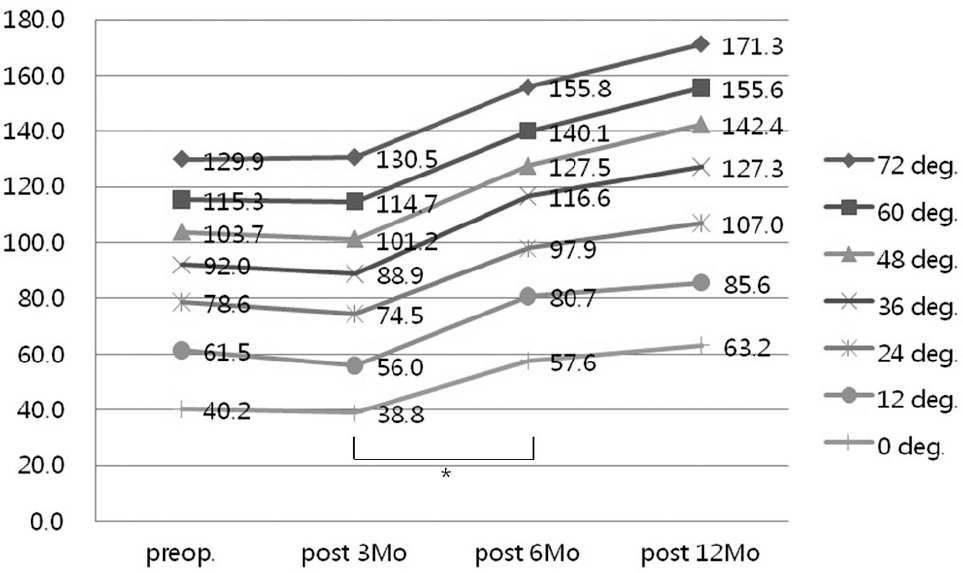
Fig. 3.
After lumbar fusion surgery, the mean isometric extension strength increased significantly and the mean ratio of 72°/0° isometric strength decreased significantly, particularly between postoperative 3 and 6 months* (p<0.001 and 0.007, respectively). The mean isometric strength showed a significant negative association with the ratio of 72°/0° isometric strength (r=-0.371, p<0.001).
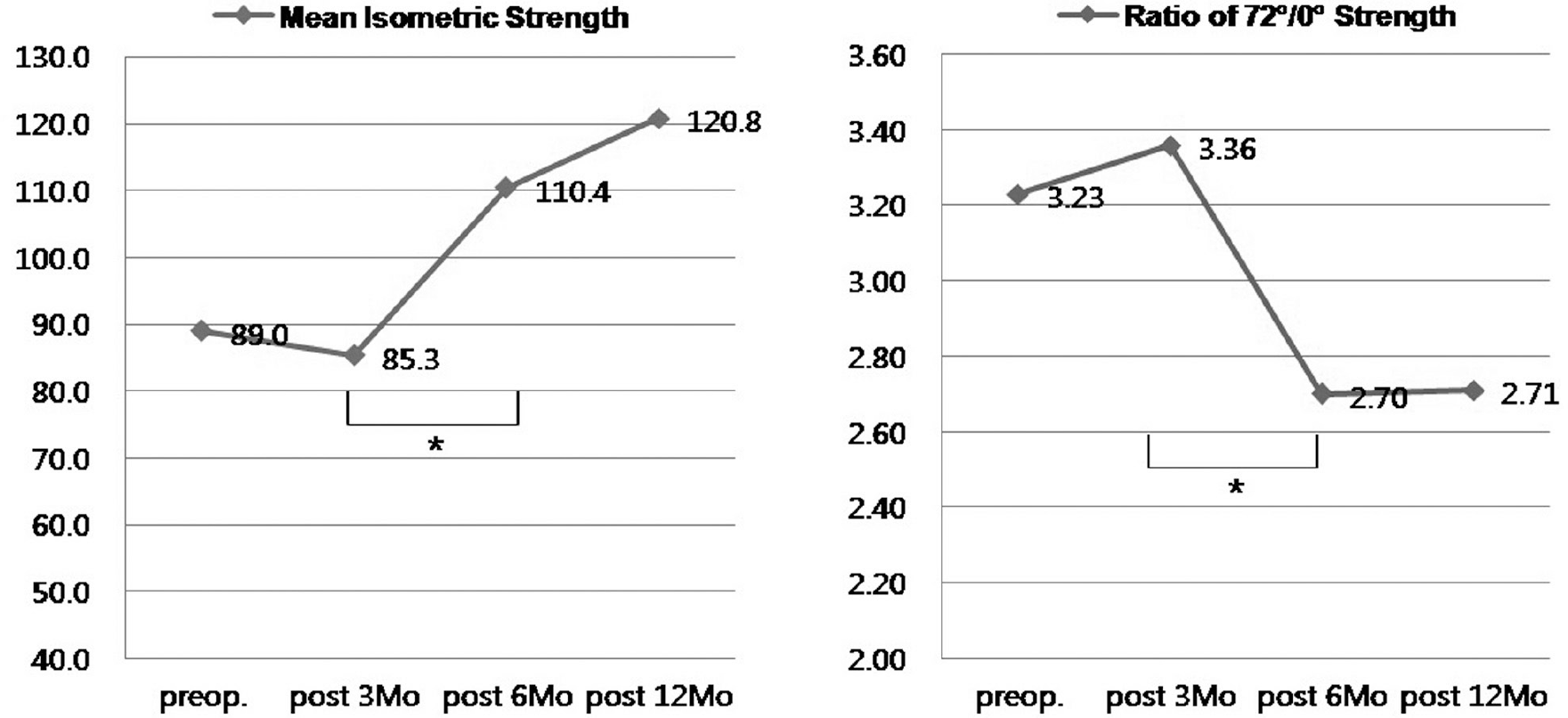
Fig. 4.
In comparisons of the mean isometric strength according to patients’ age and fusion level groups, preoperative isometric strengths were not significantly different, but the increases of isometric strengths were lower in older patients and long level fusion group (*p<0.05).
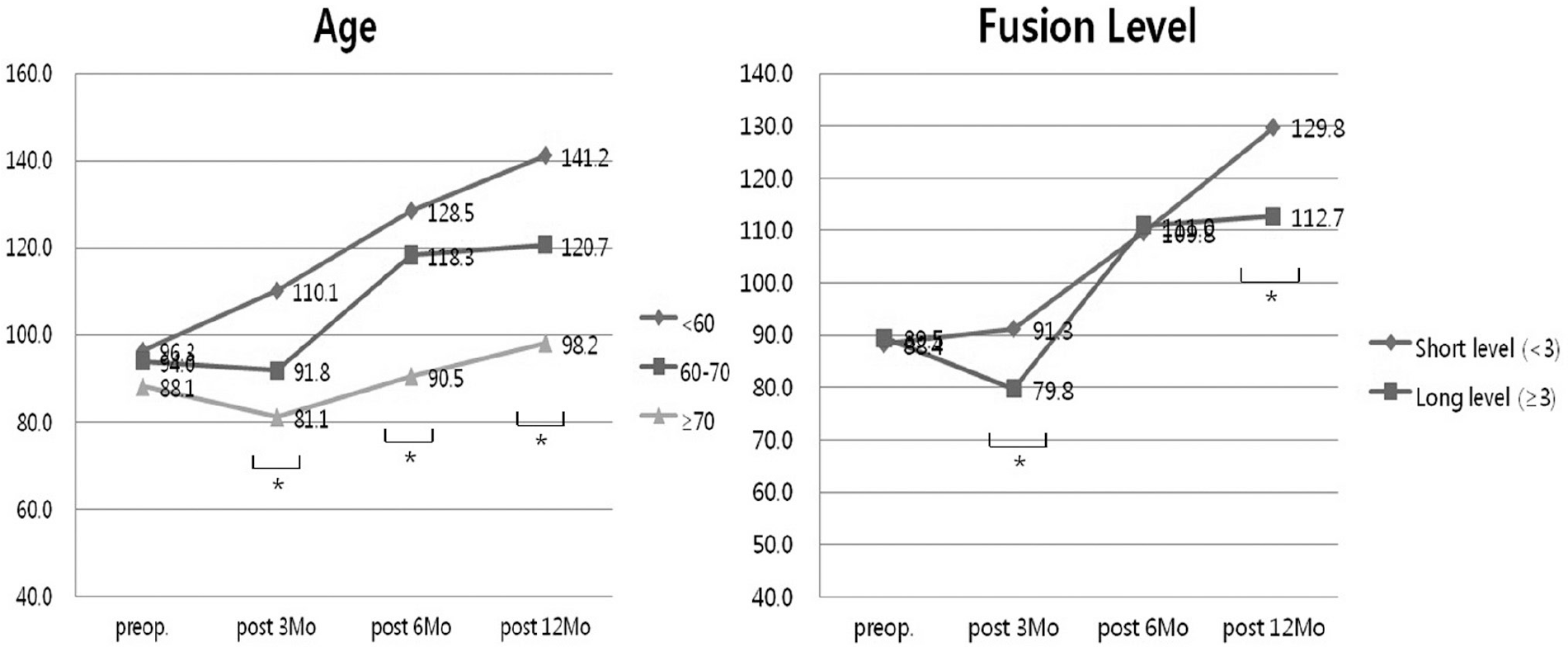
Fig. 5.
After lumbar fusion sugery, the ODI and VAS for back decreased gradually until postoperative 12 months and significant decreases were obseved between preoperative and at postoperative 3 months* (p=0.045 and 0.022, respectively).
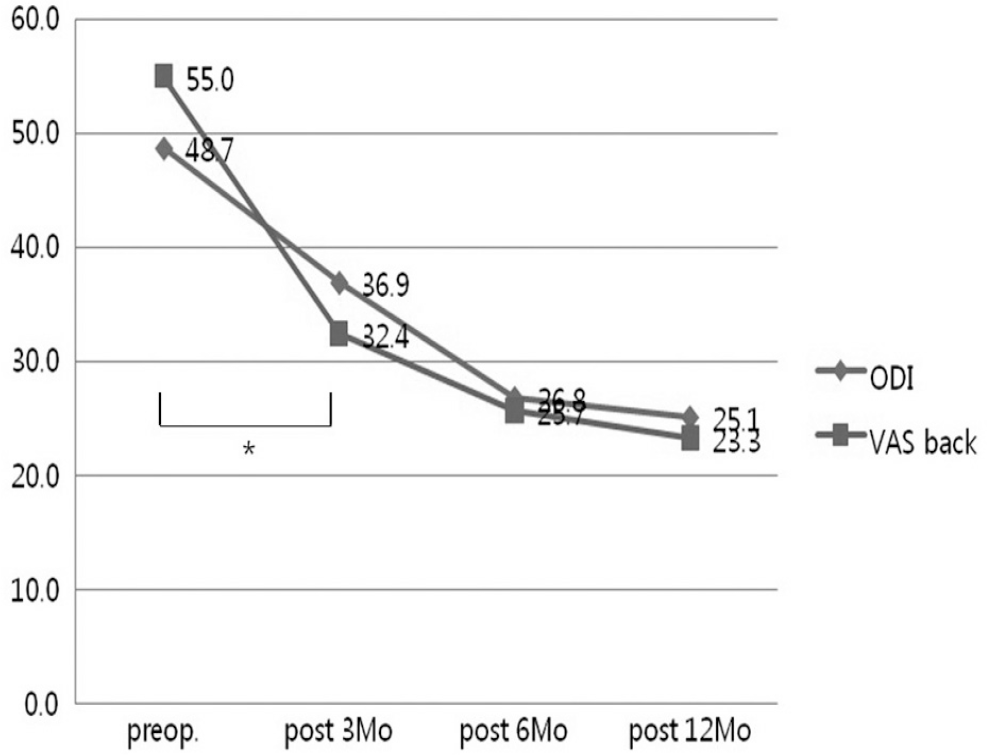
Table 1.
Baseline demographic and clinical data




 PDF
PDF ePub
ePub Citation
Citation Print
Print


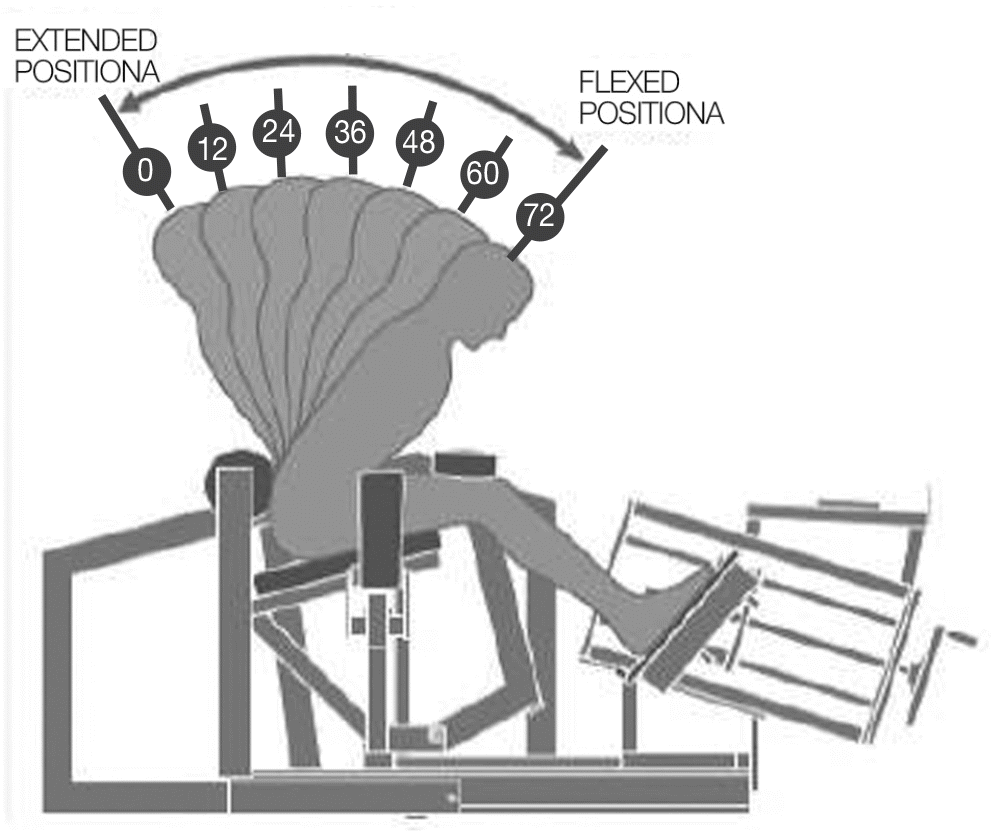
 XML Download
XML Download